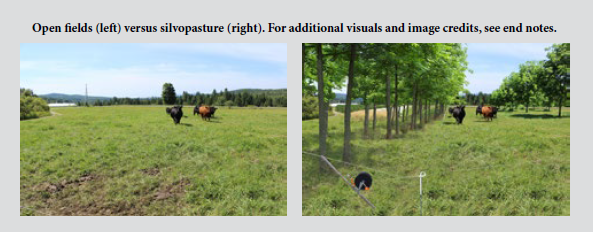Editor’s note: This brief is part of the Vermont Agriculture & Food System Plan 2021-2030 submitted to the legislature in January 2021. To read the full plan, please go to
Lead Author: Juan Alvez, University of Vermont Extension
Contributing Authors: Meghan Giroux, Vermont Edible Landscapes; Alex DePillis, VAAFM; Graham Unangst-Rufenacht, Rural Vermont; Cheryl Herrick, UVM Center for Sustainable Agriculture
What’s At Stake?
Vermont’s 4.465 million acres of forest cover around 73% of its territory. If we are to address the critical moment facing Vermont agriculture, sustainable agroforestry should be among the solutions considered and implemented. Done well, it can enhance Vermont’s working landscape, supporting farmers’ livelihoods, local economies, and our natural ecosystems. This short, medium, and long-term strategy can provide additional food, fiber, timber, carbon sequestration, water quality, habitat restoration, and increased livestock comfort and yields, but will need institutional support to provide farmers with sufficient capacity, expertise, and financing. Further, agroforestry can be part of an effective payment for ecosystem services system for Vermont’s agricultural working lands and economy.
Current Conditions
Agroforestry (agriculture and forestry) is the deliberate, integrated management of trees, crops, and sometimes livestock within the same area. It can enhance agricultural lands and complement natural forests, and produce food, feed, fiber, fuel, and timber products. Five agroforestry practices are recognized by the USDA including riparian forest buffers, alley cropping, windbreaks, forest farming, and silvopasture. Agroforestry provides multiple environmental benefits and is an effective climate change mitigation strategy3. Agroforestry can sequester thousands of tons of carbon annually, at a conservative rate of one ton per acre per year.
Existing cropland and pastureland production can be ecologically and economically enhanced with appropriate agroforestry implementation. Agroforestry can increase farm business revenue when farmers complement feed, food, or fiber production by adding timber and/or other forest products as another crop from the farm. Agroforestry helps farmers adapt to climate change by integrating more trees and more diverse tree crops that can tolerate new climate conditions, for example grazing animals in well-managed marginal forest lands converted to silvopasture. Agroforestry products can include mushrooms and maple syrup, nuts, fruits, and wood products. Using management-intensive grazing, silvopasture may increase viable grazing capabilities. Silvopasture is one of the agroforestry practices done in Vermont, with 4.6% of Vermont’s woodland acres grazed.
Vermont officially encourages two practices, riparian buffers and windbreaks, through Natural Resources Conservation Service (NRCS) payments. Windbreaks can increase crop yields 5% to 45%,6 and reduce climate stress in livestock, increasing their performance. Energy savings
in buildings sheltered by windbreaks range from 10% to 40% annually. Adding additional practices to NRCS program would benefit the sector.

Bottlenecks & Gaps
• There is an overall lack of awareness and knowledge about agroforestry practices, benefits, and
recommendations, including among licensed foresters and NRCS technical service providers.
• There is a lack of research, outreach and UVM Extension services to inform others about the
agroforestry practices being adopted by some Vermont farmers with various degrees of success. Most farmers and service providers have never seen a functional agroforestry system and aren’t aware of potential outcomes, opportunities, or barriers.
• There is a lack of guidance in the Use Value Appraisal system (i.e., Current Use Program), which is one of the barriers to adoption of integrated agroforestry practices.
• There is an absence of nursery stocks, and processing and storage facilities, to boost production and marketing of less-common value-added products derived from agroforestry (e.g., nuts).
• While viability analyses for various agroforestry practices exist and show good returns on investment, infrastructure and markets are immature, small, or lacking.
Opportunities
• As Vermont agriculture continues to shift, especially given farm succession issues and climate change, we should consider advancing comprehensive changes that look at ecological and economic solutions such as agroforestry.
• Single or multiple tree species can be used in agroforestry systems, enabling farmers to minimize
market and environmental risks and increasing business and environmental sustainability.
• Developing an agroforestry culture and industry could create new jobs (e.g., processing, education, equipment and tool manufacturing, distribution, maintenance, technical service provision, etc.).
• Due to agroforestry’s ability to deliver multiple environmental benefits, it provides farms a pathway to receive payments for ecosystem services.
Recommendations
• Create a “Center of Excellence in Agroforestry” with a multi-disciplinary stakeholder team, to develop the vision, goals, and strategy to support farms to adopt agroforestry. This Center would be hosted at a higher education and research institution and include demonstration sites (e.g., commercially viable farms), training, and research.
• Vermont NRCS should adopt Vermont-specific practice standards for the three remaining USDA agroforestry practices of silvopasture, alley cropping, and forest farming. This enables technical assistance and NRCS funding to be unlocked for farmers.
• Create a guidance document developed jointly by the Agency of Agriculture, Food and Markets and Agency of Natural Resources that clarifies the conditions under which the USDA’s five agroforestry practices, especially silvopasture, qualify for the Current Use Program.
• Provide a combination of low-interest loans and grants for on-farm diversification, including managing existing trees and encouraging establishment and management of new agroforestry enterprises. Pair public and private institutions and investors with farmers in search of capital to implement agroforestry practices and access to markets.
• A Vermont payment for ecosystem services program should include agroforestry as a qualifying practice, and other financial incentives should also be considered.
• Support access to new markets through developing processing and storage facilities (e.g., licensed commercial kitchens or facilities), where agroforestry farmers can bring their products for processing, dehulling and milling, refrigeration, and packaging, etc., to create value-added products.

